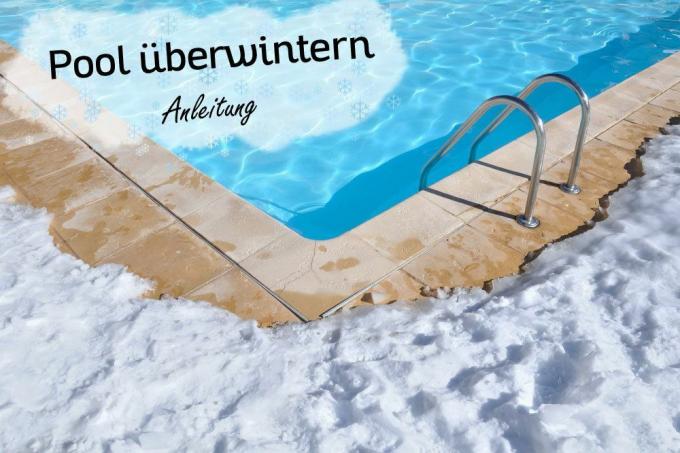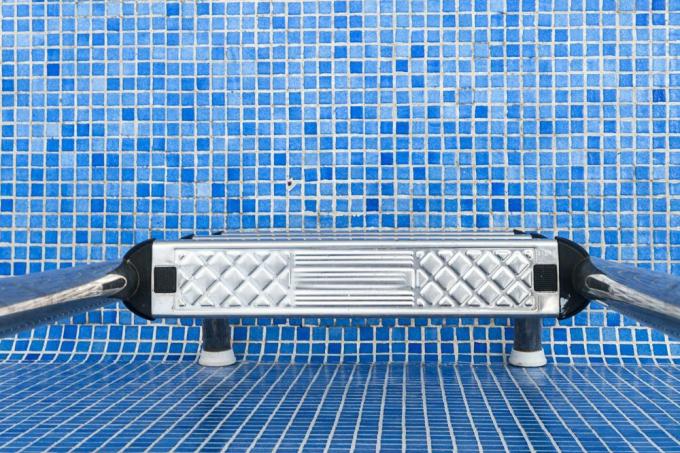
table of contents
- Hibernate the pool
- Main problem with ice
- Hibernate pool: instructions
- 1. Adjust pool water
- 2. Lowering the water level
- 3. Clean
- 4. Empty lines
- 5. Ice pressure pads
- 6. Ladders
- 7. Cover
- 8. Dismantling
In many gardens, the swimming pool is now one of the facilities that can almost be described as standard. It offers real added value and delights users, especially on hot summer days. But what happens to it over the winter? How can you properly overwinter a pool? And does the water have to be drained off? Our instructions explain.
Hibernate the pool
At first, one could assume that a pool would ultimately not care if the sun is shining outside and summer temperatures prevail, or whether freezing cold the thermometer fall below freezing point leaves. But that is definitely not the case. Because even if at first glance there is "only" a water basin, a wide variety of components are particularly stressed by the weather in winter:
- The pool itself with waterproofing and supporting structure
- The pump
- The filter system
- All water-carrying pipes
- Any existing chemical dosing systems
- Accessories for and in the pool made of plastic or rubber
The critical factors that make up this particular stress are listed much more quickly:
1. low temperatures: Plastics and rubber become brittle when temperatures drop and age faster under stress. Movements are more poorly absorbed and seals give way more quickly to the water pressure.
2. ice and snow: One consequence of the low temperatures is additional pollution when precipitation freezes or falls from the sky as snow. These additional weights can stress covers and, in connection with the embrittlement of plastic, sometimes also damage them.
Main problem with ice
By far the most important topic, however, is ice cream. And not in the form of freezing rain or snow, but as a result of the aggregate change in normal pool water in winter. Although the water is initially no more or less than in summer, its change when it reaches freezing point has a glaring effect on the wintering of the pool. The cause is the increase in volume of water when it freezes. The space taken up increases by 1/11, i.e. around 9 percent, due to the transition from liquid to solid. Now imagine that all of a sudden there is 9 percent more water volume in the pool that suddenly takes up space. Understandably, this creates a look on the pool walls enormous pressure.
The same thing happens in pipes, technical components and everywhere else where there is still water. While the pool itself has to withstand high loads anyway and still the open way to at least for part of the increase in volume remains at the top, water in closed components quickly leads to failure of seals, connections or the component self. Even metal pipes are unable to withstand the pressure of the ice and, in extreme cases, are downright blasted. Anyone who thinks that the complete elimination of all water is the universal solution is mistaken. Because there is of course water in the surrounding soil. This also freezes and, in addition to the pressure of the ice in the pool, exerts an opposing force on the pool basin from the outside. The following instructions explain how to deal with these different influences correctly.
Hibernate pool: instructions
Although individual pond constructions may have different approaches to wintering require, the following steps have often proven to be a suitable and safe way through the winter time proven:
1. Adjust pool water
Set the pH value to 7.0 - 7.2 and regulate the chlorine value to a maximum of 0.5 mg / l. Then add water care products with an algicidal effect. Because with these values the pollution of the water is lowest and the spread
of bacteria, algae etc. is prevented and dirt build-up is made more difficult.
Attention: Never run one when wintering your pool Shock chlorination by! Due to the cover and the reduced solar radiation, the chlorine can only slowly break down to the setpoint and will damage the pool lining until then.
2. Lowering the water level
You should keep the water level as high as possible, but lower it at least 10 centimeters below the inlets and outlets of the filter system. Seal the enema and skimmer with a winter stopper. This means that no pool water can penetrate the technology.
tip: Either lower the water level with a submersible pump or connect a suction hose with a bottom suction device to the skimmer. If you now backwash your sand filter system, the pool will be emptied and the filter will be cleaned intensively at the same time.
Now one might ask why the water level is being lowered when pressure from the freezing ground is also exerting on the pool from outside. Even a basin that is only partially filled is able to build up sufficient counter pressure. Therefore the protection of the inlets and outlets is in the foreground here.
3. Clean
To avoid permanent adhesion of lime and dirt over the winter, remove all limescale and dirt edges and surfaces on and in the pool with a pool sponge and cleaning agents.
4. Empty lines
Empty all lines as well as filters, pumps, etc. via any drainage devices that may be present. Alternatively, the connections between the components can be loosened and the water removed. This is the only way to prevent frost splitting caused by the freezing of remaining water.
5. Ice pressure pads
Ice pressure cushions absorb the pressure when the pool water freezes and relieve the pool walls. You can insert these into the pool water either along the edge or across the pool.
6. Ladders
Remove all stainless steel components, clean them and store them in a frost-proof place to prevent damage from ice and rust from the effects of the weather.
7. Cover
To keep dirt and precipitation away from the pool and to keep the water level constant, you should cover the pool with a tarpaulin, a special cover or a sliding hall.
8. Dismantling
Sensitive components, especially technical equipment such as filters, pumps and chlorine systems, can age quickly due to the cold and moisture. You should therefore dismantle these parts and store them in a frost-proof place.
It becomes clear that the garden pool can be overwintered with a certain water level without any problems. Completely emptying, however, is not necessary. But remember to check the water level that has been brought about regularly over the winter months. Because wind and storm can cause even the best cover to slip and rain, snow and leaves can gain access to the pool. If the water level rises above the inlets and outlets, the pool water can enter there and cause the damage that was previously successfully prevented when it freezes.





